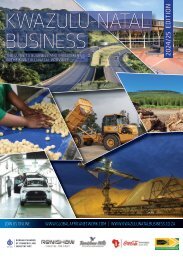Gauteng Business 2016 edition
The 2016 edition of the Gauteng Business and Investment Guide is the premier business and investment guide for the Gauteng province and the Gauteng Growth and Development Agency (GGDA). In addition to detailed profiles of key provincial organisations, including the GGDA, the Automotive Industry Development Corporation Centre (AIDC), the Gauteng Investment Centre, the Gauteng IDZ, the Gauteng ICT Park SEZ and Constitution Hill, this edition includes well-researched economic and demographic data on the province, as well as insights into the province’s five development corridors and the new industries and development nodes in these corridors; a focus on Gauteng as a global city region; and key growth sectors for the province.
The 2016 edition of the Gauteng Business and Investment Guide is the premier business and investment guide for the Gauteng province and the Gauteng Growth and Development Agency (GGDA). In addition to detailed profiles of key provincial organisations, including the GGDA, the Automotive Industry Development Corporation Centre (AIDC), the Gauteng Investment Centre, the Gauteng IDZ, the Gauteng ICT Park SEZ and Constitution Hill, this edition includes well-researched economic and demographic data on the province, as well as insights into the province’s five development corridors and the new industries and development nodes in these corridors; a focus on Gauteng as a global city region; and key growth sectors for the province.
You also want an ePaper? Increase the reach of your titles
YUMPU automatically turns print PDFs into web optimized ePapers that Google loves.
OVERVIEW<br />
transform the CoT into a more attractive region in order to create<br />
partnerships with investors interested in setting-up automotive<br />
manufacturing facilities with the view to exporting components<br />
into the Southern African market as well as to existing international<br />
trading partners.<br />
The programme aligns strongly with a number of policy drivers<br />
at national, provincial and municipal level. The expected strategic<br />
benefits of the TAC programme are as follows:<br />
• Economic growth<br />
• GDP growth<br />
• Infrastructure development<br />
• Attract Investment both foreign and domestic<br />
• Create Enterprise Development opportunities<br />
• Create thousands of jobs<br />
• Increase tax revenue<br />
• Support Government’s strategic objectives<br />
Finally, a range of incentives are available to firms and investors<br />
within the automotive industry in <strong>Gauteng</strong>. The value of incentives<br />
provided through the national Department of Trade and Industry<br />
amounts to around R5.9-million. Such incentives are a key factor<br />
in encouraging firms within the automotive industry to upgrade<br />
or expand their facilities within the province. For instance, Tata is<br />
considering converting its assembly plant in <strong>Gauteng</strong> into a full-scale<br />
production facility. This would be the company’s first big assembly<br />
plant to be developed outside India.<br />
Investment opportunities<br />
• Export of automotive components<br />
• Joint ventures with existing manufacturing companies<br />
• Non-core activities such as distribution and transport<br />
Pharmaceuticals<br />
South Africa’s pharmaceutical<br />
sector is worth approximately<br />
R20-billion annually. Although<br />
there are more than 200 pharmaceutical<br />
firms in the country,<br />
large companies tend to dominate<br />
the field, with Aspen (34<br />
percent) and Adcock Ingram (25<br />
percent) the two key players, followed<br />
by Sanofi, Pharmaplan<br />
and Cipla Medpro. A number of<br />
large pharmaceutical firms have<br />
made significant investments in<br />
South Africa. Adcock Ingram, for<br />
instance, has invested heavily in<br />
its South African operation. The<br />
company is planning to spend<br />
R1-billion on new developments<br />
and upgrades in <strong>Gauteng</strong>.<br />
The private sector accounts<br />
for 80 percent of pharmaceutical<br />
industry sales by value and<br />
20 percent by volume, while<br />
this ratio is reversed in the case<br />
of the public sector. The public<br />
sector dispenses comparatively<br />
cheap pharmaceutical products<br />
to its users in public hospitals and<br />
GAUTENG BUSINESS <strong>2016</strong><br />
102


















